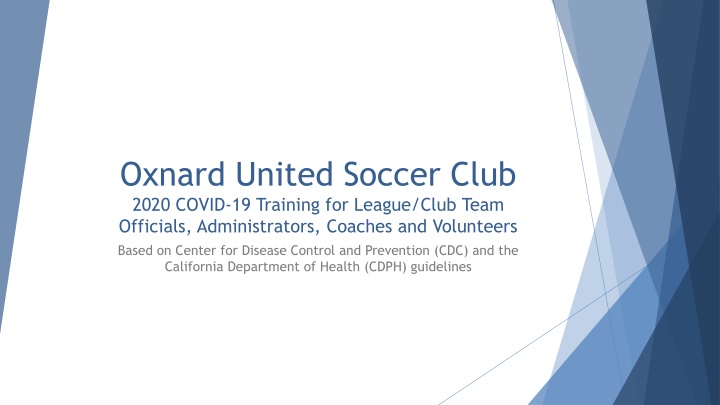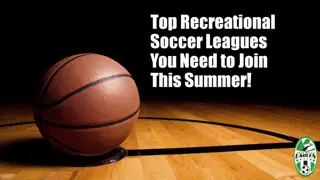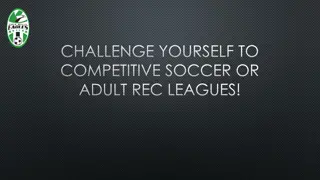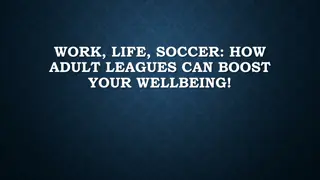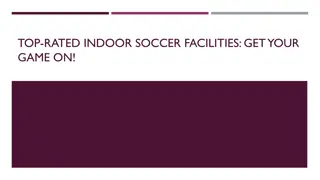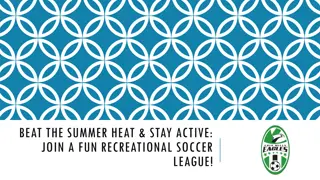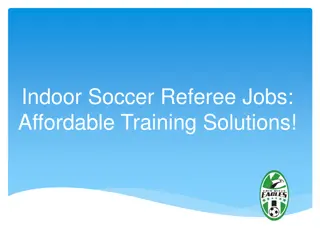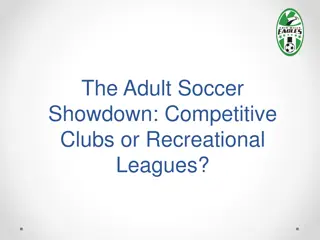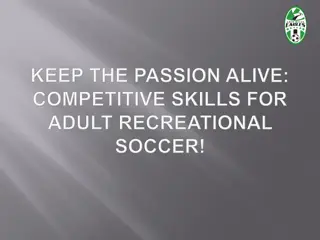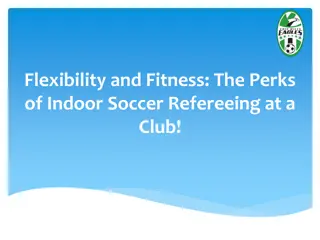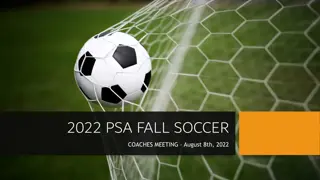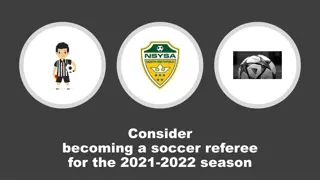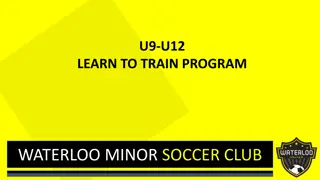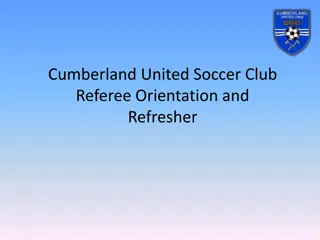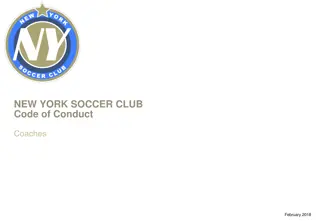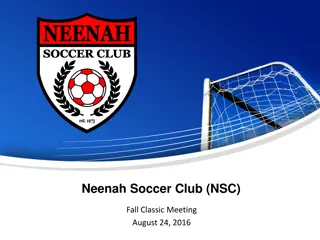Oxnard United Soccer Club
Providing COVID-19 training for officials, administrators, coaches, and volunteers based on CDC and CDPH guidelines. Ensuring safety and compliance within the Oxnard United Soccer Club to protect participants and staff during the ongoing pandemic.
Download Presentation

Please find below an Image/Link to download the presentation.
The content on the website is provided AS IS for your information and personal use only. It may not be sold, licensed, or shared on other websites without obtaining consent from the author.If you encounter any issues during the download, it is possible that the publisher has removed the file from their server.
You are allowed to download the files provided on this website for personal or commercial use, subject to the condition that they are used lawfully. All files are the property of their respective owners.
The content on the website is provided AS IS for your information and personal use only. It may not be sold, licensed, or shared on other websites without obtaining consent from the author.
E N D
Presentation Transcript
Oxnard United Soccer Club 2020 COVID-19 Training for League/Club Team Officials, Administrators, Coaches and Volunteers Based on Center for Disease Control and Prevention (CDC) and the California Department of Health (CDPH) guidelines
Agenda Introduction and Overview of COVID-19 Screening of Participants Restriction of Participation Return to Play Contact Tracing Hygiene and Prevention Social/Physical Distancing Face Covers Hand Hygiene and Respiratory Etiquette Personal Items Equipment Training Groups Summary
Introduction and Overview of COVID-19 This training is based on the information and best practices of: CDC: https://www.cdc.gov/coronavirus/2019-ncov/symptoms-testing/symptoms.html CDPH: https://www.cdph.ca.gov/Programs/CID/DCDC/Pages/Immunization/ncov2019.aspx
Introduction and Overview of COVID-19 Symptoms of Coronavirus What you need to know: Anyone can have mild to severe symptoms. Older adults and people who have severe underlying medical conditions like heart or lung disease or diabetes seem to be at higher risk for developing more serious complications from COVID-19 illness.
Introduction and Overview of COVID-19 Watch for Symptoms People with COVID-19 have had a wide range of symptoms reported ranging from mild symptoms to severe illness. Symptoms may appear 2-14 days after exposure to the virus. People with these symptoms may have COVID-19: Fever or chills Cough Shortness of breath or difficulty breathing Fatigue Muscle or body aches Headache New loss of taste or smell Sore throat Congestion or runny nose Nausea or vomiting Diarrhea This list does not include all possible symptoms. The CDC will continue to update this list as they learn more about COVID-19.
Introduction and Overview of COVID-19 When to Seek Emergency Medical Attention Look for emergency warning signs* for COVID-19. If someone is showing any of these signs, seek emergency medical care immediately Trouble breathing Persistent pain or pressure in the chest New confusion Inability to wake or stay awake Bluish lips or face *This list is not all possible symptoms. Please call your medical provider for any other symptoms that are severe or concerning to you. Call 911 or call ahead to your local emergency facility: Notify the operator that you are seeking care for someone who has or may have COVID-19.
Introduction and Overview of COVID-19 How it Spreads There is currently no vaccine to prevent coronavirus disease 2019 (COVID-19). The best way to prevent illness is to avoid being exposed to this virus. The virus is thought to spread mainly from person-to-person. Between people who are in close contact with one another (within about 6 feet). Through respiratory droplets produced when an infected person coughs, sneezes or talks. These droplets can land in the mouths or noses of people who are nearby or possibly be inhaled into the lungs. Some recent studies have suggested that COVID-19 may be spread by people who are not showing symptoms. In general, the more closely a person interacts with others and the longer that interaction, the higher the risk of COVID-19 spread. It may be possible that a person can get COVID-19 by touching a surface or object that has the virus on it and then touching their own mouth, nose, or possibly their eyes. This is not thought to be the main way the virus spreads, but we are still learning more about how this virus spreads.
Screening Participants Screen participants (Players, Coaches, Administrators, etc.) before entering facilities or fields Active Screening: Participants involved in training (Administrators, Coaches, players etc.) should conduct a daily temperature check for low grade fever (>100.4 F) before training. If participants have a fever, THEY DO NOT GO TO Training. Passive Screening: Participants involved in training (Administrators, Coaches, players etc.) should conduct a daily health questionnaire in line with the Coronavirus SelfChecker, made available by the CDC. The CDC Coronavirus SelfChecker can be found here: https://www.cdc.gov/coronavirus/2019-ncov/symptoms-testing/symptoms.html
Restriction of Participation - Players Participants do not go to training facilities or fields with any of the CDC, CDPH and/or VCPH COVID-19 symptoms: Participants are to remotely communicate their health status to coaches, instructors, team administrators, or medical staff if presenting with symptoms as soon as possible. Parents (and not the minor player) should communicate with an administrator or coach, in accordance with the SafeSport Framework and the U.S. Center for SafeSport policies and guidance. Participants should speak to a physician and follow CDC, CDPH and/or VCPH COVID-19 guidelines on self-quarantine.
Return to Play After a Positive Test For individuals who have tested positive for COVID-19, written confirmation of COVID-19 negative status and clearance from your physician must be provided to the Administration in order to return to full participation in sport & activity.
Contact Tracing For contact tracing purposes, the teams must maintain a list of all facility (training area) users, participants at trainings, and attendees, etc. For privacy purposes, the list should be securely stored and not shared publicly. If someone participating in your activities becomes ill, refer to this list for tracking or tracing to determine who at your training may have been directly exposed to illness, and advise them accordingly. Include the items below in your contact tracing list. For minors, use a parent s contact information. Collect the following information from the affected participant: Date Venue Name Team Phone number Email Address Specific Training session information (Time, Facility, Coach) Follow CDC, CDPH and/or VCPH COVID-19 notification guidance Notify those who had close contact with affected participant
Hygiene and Prevention Social/Physical Distancing What you need to know: Avoid close contact with people who are sick, even inside the home. If possible, maintain 6 feet between the person who is sick and other household members. Put distance between participants. Remember that some people without symptoms may be able to spread virus. Participants should stay at least 6 feet (about 2 arms length) from other people. Keeping distance from others is especially important for people who are at higher risk of getting very sick. Instruct participants and staff that all protocols involving physical contact such as hugs, high- fives, etc. are not allowed. To assist with physical distancing, lines/markers/cones should be utilized with six (6) foot of separation for staff and participants to maintain safe social distances to enter or exit the facility Participants should not share rides and transportation or carpool with participants from other households
Hygiene and Prevention Face Coverings Teach and reinforce the use of cloth face coverings. Face coverings are not intended to protect the wearer, but rather to reduce the risk of spreading COVID-19 from the person wearing the mask (who may not have any symptoms of disease). Face coverings may be challenging for players (especially younger players) to wear while playing sports. Face coverings should be worn by coaches as well as, youth sports staff, officials, parents, and spectators as much as possible. Wearing cloth face coverings is most important when physical distancing is difficult. People wearing face coverings should be reminded to not touch the face covering and to wash their hands frequently. Information should be provided to all participants on the proper use, removal, and washing of cloth face coverings. Note: Cloth face coverings should not be placed on: Babies and children younger than 2 years old; Anyone who has trouble breathing or is unconscious; Anyone who is incapacitated or otherwise unable to remove the cloth face covering without assistance.
Hygiene and Prevention Hand Hygiene and Respiratory Etiquette Teach and reinforce handwashing with soap and water for at least 20 seconds If soap and water are not readily available, hand sanitizer that contains at least 60% alcohol can be used (for staff and older children who can safely use hand sanitizer). Require all participants to wash or sanitize their hands before entering the facility. Hand sanitizer should be available for each stable youth sports group throughout the facility. Participants will be required to wash their hands immediately after drills or practice are completed. Do not allow spitting and encourage everyone to cover their coughs and sneezes with a tissue or use the inside of their elbow. Used tissues should be thrown in the trash and hands washed immediately with soap and water for at least 20 seconds. If soap and water are not readily available, hand sanitizer that contains at least 60% alcohol can be used.
Hygiene and Prevention Personal Items Participants will handle and care for their own equipment. Coaches, facility staff or volunteers will not be allowed to handle individual participant s equipment. All participant and staff personal items such as bags, cell phones, personal reusable water flasks/bottles and backpacks will only be allowed in the facility or on the field if proper space is maintained between all items. Participants should bring their own water bottle to each training Participants should bring their own ball/training equipment to each training as much as possible Coaches, administration or volunteers should use cones or other markers to create designated areas for each participant to keep their personal items, ensuring that there is a minimum of 6-feet of distance between the items of each participant
Hygiene and Prevention Equipment - General Sports equipment must be designated and marked for each Training group. This equipment must not be allowed to be used by any other Training group unless sanitized. Sanitize all sports equipment necessary for practice and drills for each Training group after they are collected and before they are returned to circulation. The minimum equipment necessary must be used for practices and drills. All equipment will be placed so that it can be retrieved without touching anything but the equipment.
Hygiene and Prevention Equipment - Cleaning and Disinfection Clean and disinfect frequently touched surfaces on the field, court, or play surface (e.g., drinking fountains) at least daily, or between uses as much as possible. Use of shared objects and equipment (e.g., balls, etc) should be limited, or cleaned between use by each individual if possible. Develop a schedule for increased, routine cleaning and disinfection. Ensure safe and correct use and storage of disinfectants, including storing products securely away from children. Use products that meet EPA disinfection criteria found here:https://www.epa.gov/pesticide-registration/list-n-disinfectants-use-against-sars- cov-2-covid-19 Identify an adult staff member or volunteer to ensure proper cleaning and disinfection of objects and equipment, particularly for any shared equipment or frequently touched surfaces. Cleaning products should not be used near children, and staff should ensure that there is adequate ventilation when using these products to prevent children or themselves from inhaling toxic fumes. Use gloves when removing garbage bags or handling and disposing of trash. Wash hands after removing gloves.
Hygiene and Prevention Equipment Shared Objects Discourage sharing of items that are difficult to clean, sanitize, or disinfect. Do not let players share towels, clothing, or other items they use to wipe their faces or hands. Make sure there are adequate supplies of shared items to minimize sharing of equipment to the extent possible, otherwise, limit use of supplies and equipment to one group of players at a time and clean and disinfect between use.
Training Groups Practice or drill times will be monitored to regulate the number of youth participants at the facility at one time to ensure social distancing between Training Groups. Participants within a Training group may not arrive at the facility until the previous group has completely left. At no time will the Training group or the staff assigned to that group be allowed to intermingle or move between groups. Limit the number of participants in the facility at any one time that always allows for participants and employees to maintain at least six (6) feet distance from one another . Breaks will be organized so that designated Training groups will not intermingle and social distancing of six feet or greater can be achieved. Training groups must abide by the maximum number of players allowed in a Training Group based on State and/or Local social distancing guidelines. Designated and separated practice areas and equipment for each Training Group will be prepositioned to maintain safe social distancing. All staff must be instructed to maintain six (6) feet of distance from participants and from other employees whenever feasible.
Conclusion Ultimately, coaches, administrators, faculty, staff and volunteers are responsible for creating and maintaining a safe environment. Players must be responsible to adhere to and respecting the social distancing requirements and contact guidelines defined by each Phase. Organizations will divide participants into smaller stable sports groups limiting group participation to the recommended number provided by the region s jurisdiction. These groups should be consistent throughout the session and rostered as such. If a parent or guardian is not comfortable their child s returning to play, they should not return to play and it should not affect their standing in any way with the team.
